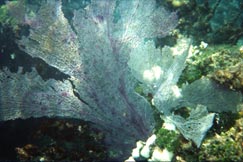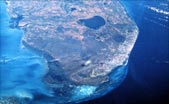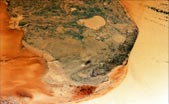 Coral reefs are the most biologically diverse marine ecosystems on
earth, rivalled only by the tropical rainforests.
Coral reefs are the most biologically diverse marine ecosystems on
earth, rivalled only by the tropical rainforests.
Coral reefs are the oldest natural ecosystems existing on Earth today and the largest living structures on the planet, often hundreds of miles long.
The rate of growth for a coral reef is very slow, typically half an inch per year.
Even though coral reefs cover a tiny portion of the ocean floor, they contain approximately one quarter of the ocean's species. Almost 5,000 species of reef fish and 2,500 species
of coral have been identified.
Sixty percent of the world's population - that's almost four billion people - live within 100 miles of an ocean. Most of those people depend on fish and shellfish from the reefs as their principal source of protein.
Coral reefs appear to be rocks or plants, but they are actually structures formed by tiny animals, called polyps, that range in size from the head of a pin to a pinky finger.
An individual coral polyp contains within its body even smaller plants, or algae, known as zooxanthellae. "Zooxanthellae" is a Greek word that means little yellow creature. This tiny algae keeps the coral alive by helping it breathe.
The third largest coral reef in the world is found right here in the United States off the Florida Keys. The Keys are the number one dive destination in the world.
The world's coral reefs are being damaged by disease, human development, and water pollution. Scientific studies show that up to three-quarters of the world's coral reefs may be gone in the next forty years if destruction continues
at its present rate. Over 70% of the reefs in the Philippines and Indonesia are already damaged beyond repair.
Here's what coral reefs do for us:

provide shorelines with protection from storms and breaking waves,
serve as nurseries for growing fish,
supply a protein source in coastal people's diets,
give food, shelter and protection to a variety of marine species,
provide jobs through fishing and tourism,
serve as a source of medicine against a variety of illnesses,
give us a wondrous underwater world to study and enjoy.
Here's what we do to coral reefs:

pollute them with sewage, oil spills, fertilizers and pesticides,
fish them in destructive ways,
mine them with explosive devices,
smother them with silt resulting from logging, land use and development,
run boats and propellers onto them,
drop anchors on them, step on them, drag dive gear over them,
chop them down for tacky jewelry and coffee table curios.

